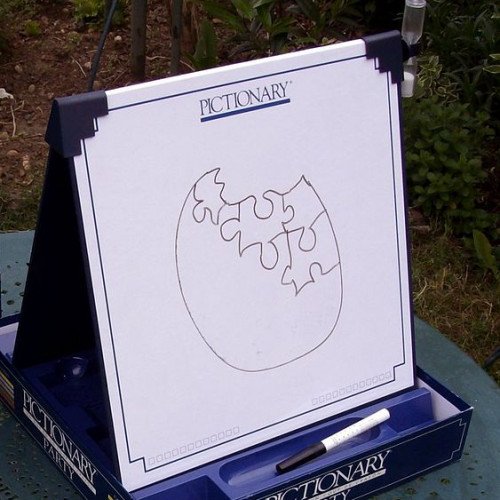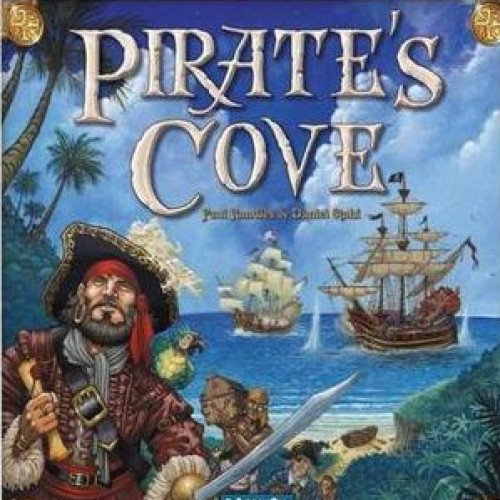"PICTIONARY" vs "PIRATE'S COVE"

PICTIONARY
Pictionary (/ˈpɪkʃənəri/, US: /-ɛri/) is a charades-inspired word-guessing game invented by Robert Angel with graphic design by Gary Everson and first published in 1985 by Angel Games Inc.[1] Angel Games licensed Pictionary to Western Publishing. Hasbro purchased the rights in 1994 after acquiring the games business of Western Publishing. [2] Mattel acquired ownership of Pictionary in 2001. The game is played in teams with players trying to identify specific words from their teammates. The concept of Pictionary was first created by Robert Angel and his friends in 1981. Angel and his roommates came up with the concept of the game, which proved to be very popular between them. While originally hesitant to pitch the idea, Angel was inspired by Trivial Pursuit, the gameplay of which was similar to his concept and proved to him that such gameplay could work and be successful.[3] Angel and his business partners Terry Langston and Gary Everson first published Pictionary in 1985 through Angel Games. A week before Pictionary was first launched, Angel Games' printing company called to inform them that they could not sort through the 500,000 cards they had printed out. Angel and his partners had to sort through the cards themselves over the course of six days.[3] They managed to sell 6,000 copies in one year at $35 each.[4] Angel Games licensed the game in 1986 in a joint venture between The Games Gang and Western Publishing. In 1994, Hasbro took over publishing after acquiring the games business of Western Publishing.[5] In 2001, Pictionary was sold to Mattel. At that time they were in 60 countries and 45 languages, with 11 versions just in the US and a total of 32,000,000 games sold worldwide. Each team moves a piece on a game board formed by a sequence of squares. Each square has a letter or shape identifying the type of picture to be drawn on it. The objective is to be the first team to reach the last space on the board. To achieve this a player must guess the word or phrase being drawn by their partner, or if the player lands on an "all play" square, one player from each team attempts to illustrate the same concept simultaneously, with the two teams racing to guess first. The first player to land and guess correctly at the finish wins.
Statistics for this Xoptio

PIRATE'S COVE
Pirate's Cove (German: Piratenbucht) is a board game designed by Paul Randles and Daniel Stahl, originally published in Germany in 2002 by Amigo Spiele, illustrated by Markus Wagner and Swen Papenbrock. In 2003, Days of Wonder republished the game with a new graphic design from Julien Delval and Cyrille Daujean. In the game, players play pirate ship captains seeking treasure from islands and bragging rights from defeating other pirates in naval combat. The game takes place over 12 months (turns), with the goal of being the pirate with the most fame. Each player has a ship token and a card showing four aspects of the ship (crew, cannon, sail, and hull). At the beginning of each turn, a card is turned over at each island to reveal the potential booty from plunder. Each island (except Pirate's Cove and Treasure Island) offer various amounts of Fame, Gold, Treasure or Tavern cards. Captains choose an island to plunder based on the potential rewards of that island and then fight if they show up at the same island. Certain islands offer the opportunity to upgrade an aspect of the ship and the available plunder at each island changes with each turn. A player can use this information to predict where other players' ships will turn up and thus move his ship accordingly to either do battle or avoid it. The bounty of each island is skewed so that some Islands are clearly better choices than others, so it can force you to decide (or bluff) if you think you can take the island should other pirates go after the same bounty. Ships that survive combat then plunder the islands, gain fame, and pay gold to upgrade their ships based on the qualities of the islands. The Legendary Pirate, a black ship token, moves clockwise around the board, forcing captains to steer out of his path unless they think that they can defeat the powerful ship. At Treasure Island, no battle can take place and it is where ships can safely discharge cargo from their ship and bury any plundered treasure (a ship's capacity to hold treasure is based on its hull rating). Burying treasure and money adds to the player's accumulated fame points.